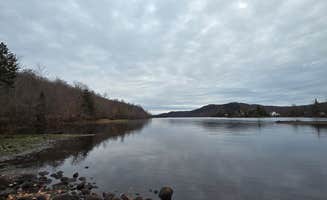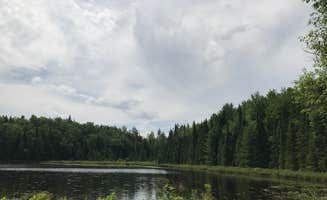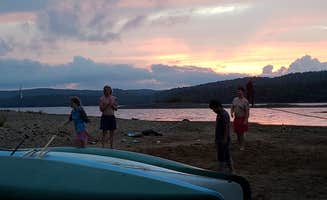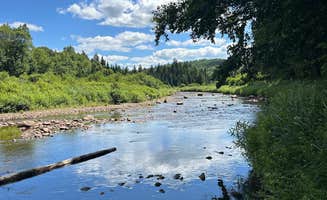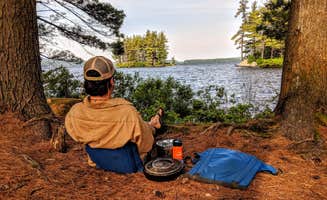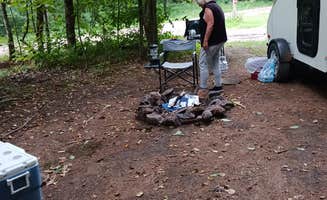Primitive camping near Otter Lake, New York takes visitors deep into the southern Adirondack region where spring thaws often create muddy access roads lasting through early June. Most dispersed sites require a minimum quarter-mile trek from parking areas, with many accessible only by water transportation. Fall temperatures drop quickly after mid-September, with overnight lows often dipping into the 30s while daytime temperatures remain comfortable for hiking and exploring.
What to do
Paddling to island camping: At Cranberry Lake Backcountry Sites, visitors can paddle to Catamount Island for a secluded experience. "We spent 3 nights backcountry camping on Catamount Island in Cranberry Lake and absolutely loved it! The sunsets from the island were truly incredible," reports Shari G. The island offers hiking trails accessible by boat, with Curtis Pond trail being a favorite despite seasonal mosquitoes.
Fishing for native species: Fish local waters for smallmouth bass, northern pike, and various panfish. Water levels can fluctuate seasonally, with mid-summer being optimal. Most dispersed sites provide direct water access for both shore and boat fishing throughout the region.
Hiking to observation points: The Stillwater fire tower trail near the Blue Lagoon primitive site provides elevated views of the reservoir and surrounding wilderness. This 1.9-mile moderate trail includes 360-degree panoramic views from the restored fire tower. Pack sufficient water as there are no sources along the trail.
What campers like
Privacy despite road proximity: At Cod Pond Dispersed Pull-Off, campers appreciate the blend of accessibility and seclusion. "The site has its own private road. A car is not recommended. Possible to turn around but you definitely need a smaller SUV," notes Taylor A. The sound of the nearby river helps mask occasional road noise.
Swimming in clear waters: Natural swimming areas with sandy bottoms exist throughout the region. Elizabeth B. described Blue Lagoon saying, "The swimming is fantastic - water is clean and clear." Most swimming areas lack defined beaches, requiring scrambling down banks to access water.
Wildlife observation: Dawn and dusk provide optimal wildlife viewing times at Stillwater Reservoir, with diverse species active in warmer months. "We saw Bald Eagles and Loons, enjoyed swimming, canoeing and paddleboarding with the family," mentions Christie M. about their experience at site #37.
What you should know
Limited cell coverage: Plan for communication blackouts at nearly all primitive sites in the region. "No AT&T cell service in this area," reports Meghan B. about Powley Road in Ferris Wild Forest. Satellite communicators are recommended for emergencies.
Water filtration necessity: Potable water isn't available at dispersed sites, requiring filtration from lakes or streams. "You will either need to bring your own potable water or filter from the lake, so don't forget your water filter," advises Shari G. Most campers recommend bringing at least one gallon per person per day.
Vehicle limitations: Many access roads require high-clearance vehicles and might be unmarked or poorly maintained. "The road is rough but easily doable if you take it slow," notes Rebecca B. about accessing Horseshoe Lake. Several sites require backing in or out due to limited turning space.
Tips for camping with families
Start with accessible sites: North Lake Reservoir Campground offers sites suitable for families with younger children. "32 sites all around the lake. Some are walk in right on the lake. Quiet, peaceful, and clean," reports J B. These sites provide shorter walks from parking areas while maintaining a primitive camping experience.
Pack insect protection: Mosquitoes can be intense from late May through August, particularly near standing water. Long sleeves, pants, and proper repellent are essential for comfort, especially during evening hours when insects are most active.
Select sites with shallow swimming: Several locations offer gradual water entry points safer for children. Look for sites with visible sandy or gravel approaches rather than steep drop-offs common along rocky shorelines.
Tips from RVers
Limited RV-suitable locations: Winona State Forest provides some of the few primitive sites accommodating smaller recreational vehicles. "Pulled in on a Thursday afternoon and found a single camp site. While there I talked to a state forest maintenance guy. He said there were currently two camping sites and that more might be added," shares Kevin C., noting the limited availability.
Solar power challenges: Dense forest canopy limits solar charging capabilities at most sites. "As it's a forest, the sites are pretty shaded, so solar and Starlink may present challenges," mentions Rebecca B. about Horseshoe Lake. Bring alternative power sources or plan for limited electricity use.
Tight access roads: Most roads leading to primitive sites have narrow clearances unsuitable for larger rigs. Smaller trailers and Class B campervans fare better than conventional RVs, with scout walks recommended before attempting access with any towable unit.


